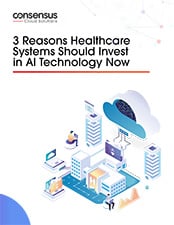Filters
Solution
Collateral Type
Care Setting
Topic
Product
5 Ways AI Technology is Driving Value for Providers Today
5 Ways NLP AI Technology is Driving Value for Providers Today
Don’t bet so big on AI solutions with “someday potential” that you ignore tools that can solve challenges and generate ROI now. Here are five critical AI investments that provide “right now” value for health systems, clinicians and patients.
“AI may be on its way to your doctor’s office, but it’s not ready to see patients,” a Los Angeles Times article proclaimed this spring. It’s not the first to remind us: For all the hype around ChatGPT and other new AI tools, we’re still a long way from widespread adoption.
But there are AI tools available for healthcare now that can demonstrate return on investment (ROI) in months, not years. These solutions strengthen referral processes and relieve pressure on overstretched healthcare teams while increasing capacity where it matters most. They also help eliminate the administrative demands of care that fuel burnout, speed information transfer, and ease transitions in care.
Here are five critical AI investments that provide “right now” value for health systems, clinicians and patients.
1. Natural language processing (NLP) and artificial intelligence (AI)-powered tools that strengthen referral processes. When physicians make referrals to specialists, the latest NLP AI advancements combined with digital fax technology ensures that no one worries about what will happen to their e-faxed referral request. For instance, when NLP and AI are applied to digital faxes, these unstructured documents can be transformed into structured, searchable data that EHR applications can digest. Then, using an integration engine, the structured data is automatically matched to the right patient’s record so providers can act on the information.
Capabilities like these put providers on another plane. They help build stronger relationships with referral partners because all the information they need is routed in their preferred workflows and in a structured format. As a result, referral workflows no longer take hours, days, or weeks. It’s an approach that works even when a partially illegible, digital fax is submitted. At one hospital, use of AI and NLP for gastroenterology referrals, which are particularly complex, allowed the hospital to automatically triage 40% to 50% of urgent-suspicion-of-cancer referrals.
2. NLP and AI solutions that reduce workforce burden. Today, 45% of inpatient nurses say they are likely to leave their role in the next six months, in part due to an unmanageable workload. That’s in part due to the amount of time nurses spend per shift hunting for information, equipment or supplies (43 minutes), communicating about care for patient hand-offs (60 minutes), and completing administrative and logistical tasks (97 minutes). Today, NLP and AI can transform handwritten or text data into a structure that can be consumed by any IT system—including the EHR—and conveyed to staff in ways that complement their workflow.


